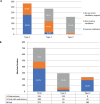A self-reported Brazilian registry of 5q-spinal muscular atrophy: data on natural history, genetic characteristics, and multidisciplinary care
- PMID: 39706225
- PMCID: PMC11661891
- DOI: 10.1055/s-0044-1792096
A self-reported Brazilian registry of 5q-spinal muscular atrophy: data on natural history, genetic characteristics, and multidisciplinary care
Abstract
Background: Spinal muscular atrophy linked to chromosome 5q (SMA-5q) is a neurodegenerative disorder caused by mutations in the SMN1 gene.
Objective: To describe the key demographic, clinical and genetic characteristics, as well as natural history data of patients with SMA-5q.
Methods: Up to January 2022, 706 patients with confirmed genetic diagnosis of SMA-5q, or their parents, completed a self-reported questionnaire on natural history, genetic characteristics, drug treatments, and multidisciplinary care.
Results: Most patients had type 1 SMA-5q (42%); with 33% having type 2, and 23% type 3. There were 667 patients (94.4%) with a homozygous SMN1-exon 7 deletion. Of the total, 131 (18.6%) patients had a previous family history of the disease, and the familial recurrence rate was higher in type 3 (25.6%). Type 1 patients had a mean age of 3 months at the onset of symptoms and a delay of more than 3 months until genetic diagnosis. The median survival of patients with type 1 without invasive ventilation was 27 months. Before 2018, the median age of use of invasive ventilation was 16 months and, after, most patients (71%) were not submitted to invasive ventilation. About 50% of patients with type 3 lost their walking ability by 37 years of age. Further, 384 (54.4%) patients had access to disease-modifying therapy, and 62.3% of type 1 patients were in treatment, compared with only 47.2% of type 2 and 31.9% of type 3 patients.
Conclusion: There is still a substantial diagnostic delay, especially in those patients with types 2 and 3 SMA-5q. However, the present study demonstrated prolonged survival, especially in type 1 patients.
Antecedentes: A atrofia muscular espinhal ligada ao cromossomo 5q (AME-5q) é uma doença neurodegenerativa causada por mutações no gene SMN1.
Objetivo: Descrever as principais características demográficas, clínicas e genéticas, assim como dados de história natural de pacientes com AME-5q no nosso meio. MéTODOS: Até janeiro de 2022, 706 pacientes com diagnóstico genético confirmado de AME-5q, ou seus pais, preencheram questionário sobre dados de história natural, características genéticas, tratamento medicamentoso e cuidados multidisciplinares.
Resultados: A maioria dos pacientes tinha AME-5q tipo 1 (42%); 33% tinham tipo 2 e 23% tipo 3. Deleção homozigótica no SMN1 foi notada em 667 pacientes (94,4%). Do total, 131 (18,6%) pacientes tinham história familiar prévia, e a taxa de recorrência familiar foi maior no tipo 3 (25,6%). Os pacientes com tipo 1 tinham idade média de 3 meses no início dos sintomas e atraso de mais de 3 meses até o diagnóstico genético. A sobrevida mediana de pacientes com tipo 1 sem ventilação invasiva foi de 27 meses. Antes de 2018, a idade mediana de uso de ventilação invasiva era de 16 meses e, após, a maioria dos pacientes (71%) não foi submetida a ventilação invasiva. Cerca de 50% dos pacientes com tipo 3 perderam a marcha em média aos 37 anos de idade. Além disso, 384 (54,4%) pacientes tiveram acesso a alguma terapia modificadora da doença; 62,3% dos pacientes tipo 1 estavam sendo tratados, comparados a 47.2% do tipo 2 e 31.9% do tipo 3. CONCLUSãO: Ainda existe um atraso substancial para o diagnóstico, especialmente nos pacientes com AME-5q tipos 2 e 3. Contudo, o presente estudo demonstrou sobrevida prolongada em pacientes tipo 1.
The Author(s). This is an open access article published by Thieme under the terms of the Creative Commons Attribution 4.0 International License, permitting copying and reproduction so long as the original work is given appropriate credit (https://creativecommons.org/licenses/by/4.0/).
Conflict of interest statement
RHM: Consultant advisory, talks, and subinvestigator of clinical trials for Biogen, Novartis, and Roche. JSAD: Nothing to declare. EZ: Consultant advisory, talks, and principal investigator for Biogen, Novartis, and Roche.
Figures





References
-
- Munsat T L, Davies K E.International SMA consortium meeting. (26–28 June 1992, Bonn, Germany) Neuromuscul Disord 19922(5–6):423–428. - PubMed
MeSH terms
Substances
LinkOut - more resources
Full Text Sources
Medical

